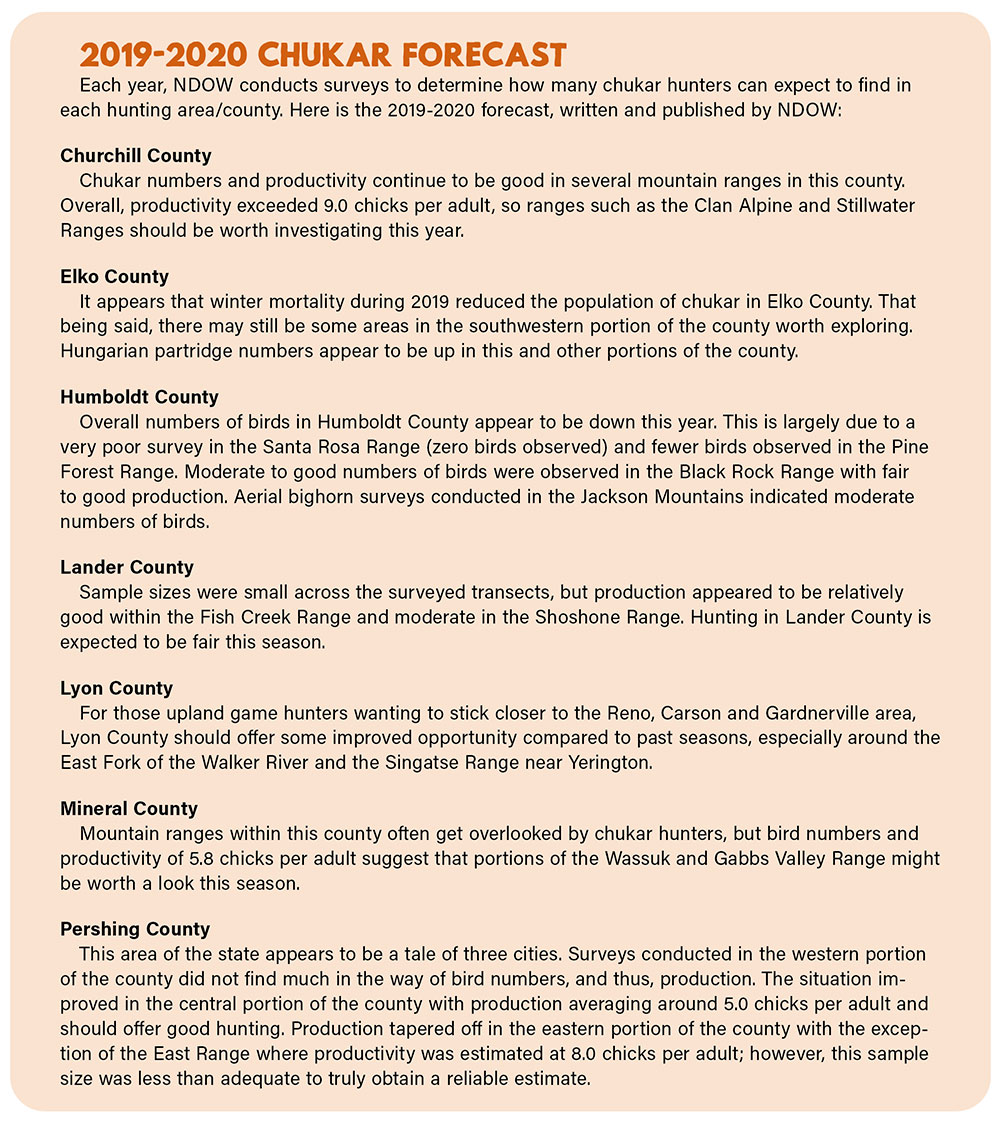Finding Feathers
January – February 2020
Nevada offers a lengthy list of upland game bird-hunting opportunities.

BY ERIC CACHINERO
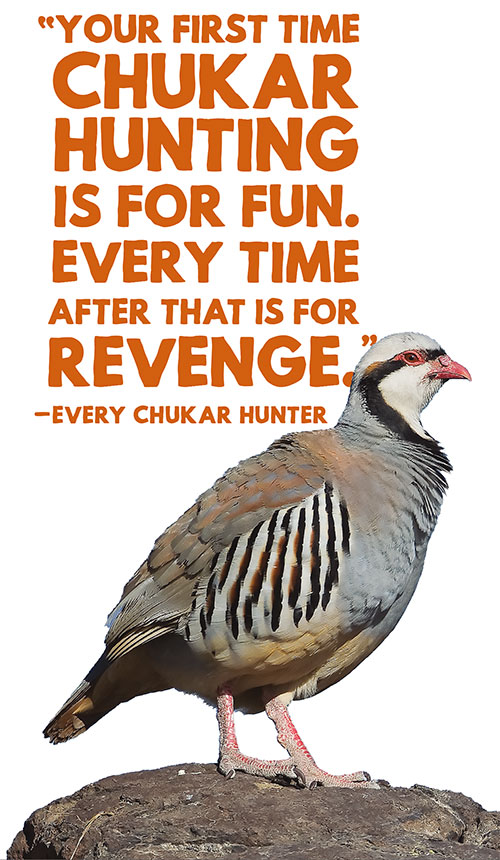
“Your first time chukar hunting is for fun. Every time after that is for revenge.” —every chukar hunter
Each seasoned bird hunter knows the feeling. The perfect conditions lead to the perfect day hunting. A warm sun complements solitude offered atop the mountain peaks, hunting dogs bound and leap with electrified energy searching for birds, and a light layer of snow on the ground reveals hundreds of tiny chukar footprints. Suddenly, the hunter hears the intoxicating and familiar chirping of dozens of chukar high on the mountain above him.
Chuck chuck chuck chuck chuck chuck chuck chuck chuck chuck chuck chuck.
 The familiar chukar calling gets louder and louder as strenuous hiking leads the hunter to the most rugged and nearly impassible rocks on the steepest, nastiest mountain he can find. Nausea from exhaustion is quickly forgotten as the excitement builds. Then, just as he reaches the top of the mountain where the chukar reside—nothing…no sounds, no footprints, nothing. Frustrated and drained, the hunter starts walking to the next mountaintop, only to hear the chukar start chirping again, “laughing” at him from the place he just left.
The familiar chukar calling gets louder and louder as strenuous hiking leads the hunter to the most rugged and nearly impassible rocks on the steepest, nastiest mountain he can find. Nausea from exhaustion is quickly forgotten as the excitement builds. Then, just as he reaches the top of the mountain where the chukar reside—nothing…no sounds, no footprints, nothing. Frustrated and drained, the hunter starts walking to the next mountaintop, only to hear the chukar start chirping again, “laughing” at him from the place he just left.
Some say you’d have to be stupid to hunt chukar, and this author and chukar hunter agrees wholeheartedly. But that’s all part of the fun—the exhaustion, the magnificent views, time in the field, time spent working with man’s best friend, and the overwhelming sense of accomplishment when you retrieve a downed bird.
Nevada’s bird-hunting opportunities expand far beyond just chukar, though. Numerous game-bird species span almost the entire state, and can be hunted by a variety of methods.
But don’t make the fatal mistake that every bird hunter makes at least once in their lives by thinking, “bird hunting is easy!”
GETTING STARTED
There are several requirements to hunt upland game in Nevada. Foremost, according to the Nevada Department of Wildlife (NDOW), anyone born after Jan. 1, 1960, must complete or show proof of completion of a hunter education course valid in either the U.S. or Canada. Information on course scheduling and requirements is available at ndow.org. Once the hunter education requirement is fulfilled, Nevada residents 18 and older have the option of purchasing either hunting or hunting-fishing combination licenses, while Nevada residents ages 12-17 may only purchase the hunting-fishing combination. Non-resident youth and adults have the option of choosing hunting-fishing combination licenses, or combination one-day permits with the option of adding consecutive days. In addition to the aforementioned options, several other specialty licenses including senior, military, apprentice, and Native American are available. Each year, NDOW publishes the “Nevada Small Game Hunting Guide,” which provides pricing, season dates, legal information, and a host of other hunting information, and can be found at ndow.org, any NDOW field office, and some sporting goods stores.
With a valid Nevada hunting license in hand, hunters simply have to use their “Nevada Small Game Hunting Guide” to ensure they are within legal hunting areas during the correct seasons and using the correct weapon, and then go afield.
BIRDS
Nevada’s selection of upland game birds is extensive. The following list describes each game bird along with a rough outline of where they can be found. All bird descriptions are provided and written by NDOW.
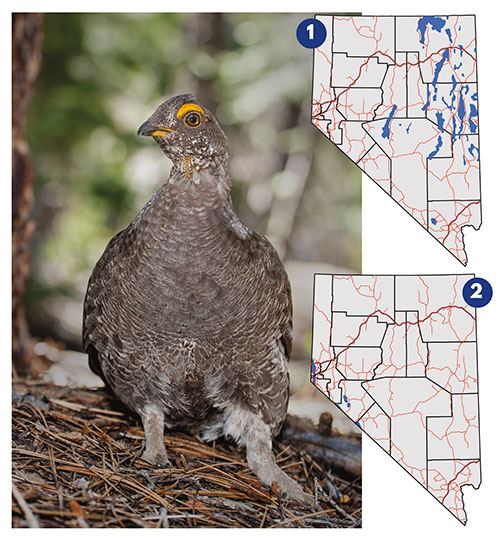
Blue Grouse (Dusky–1 and Sooty–2 Grouse)
Range in size from 15 to 20 inches and weigh from 26 to 46 oz. Dusky grouse inhabit central Nevada from around Austin, east to the Nevada/Utah border and north to the Idaho/Nevada border. Sooty grouse inhabit extreme western Nevada along the California/Nevada border in mountain ranges such as the Carson Range, Sweetwater, and White Mountains.
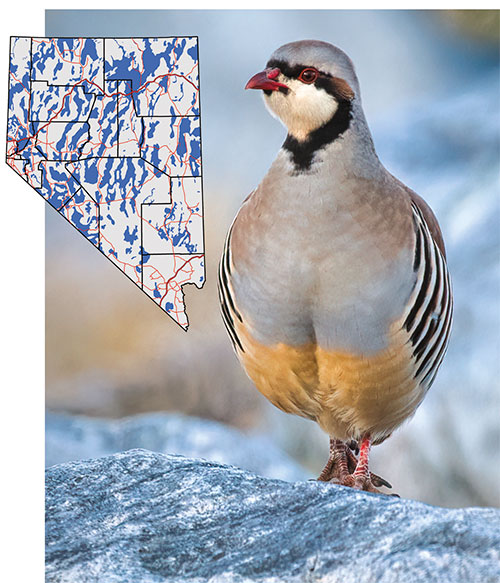
Chukar Partridge
Nevada’s most popular upland game bird. Widely distributed across the state and much of the Great Basin. Coloration is grayish brown with a buff belly. Chestnut and black barring on flanks with a black line through eye connecting at the throat. Length is 13.4 to 15 inches and weighs from 19 to 27 oz. Inhabits steep, rocky habitat exemplified by talus slopes and cliffs.
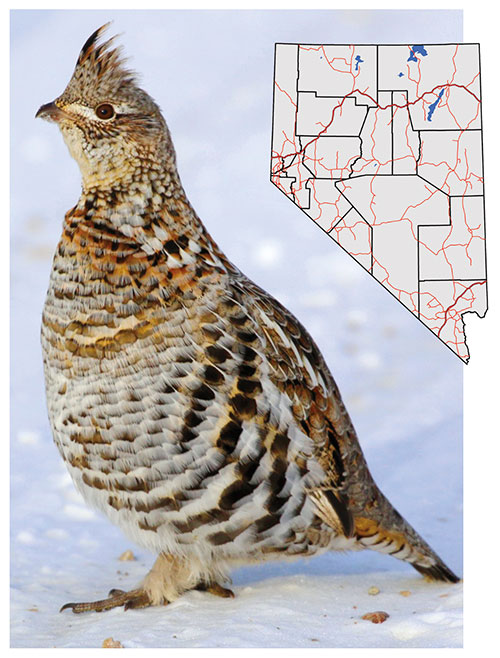
Ruffed Grouse
Reddish-brown or gray with dark bars and spots. Weighs between 16 and 26 oz. and is much smaller than a blue grouse. Translocated populations exist in northeastern, central, and portions of northwestern Nevada.
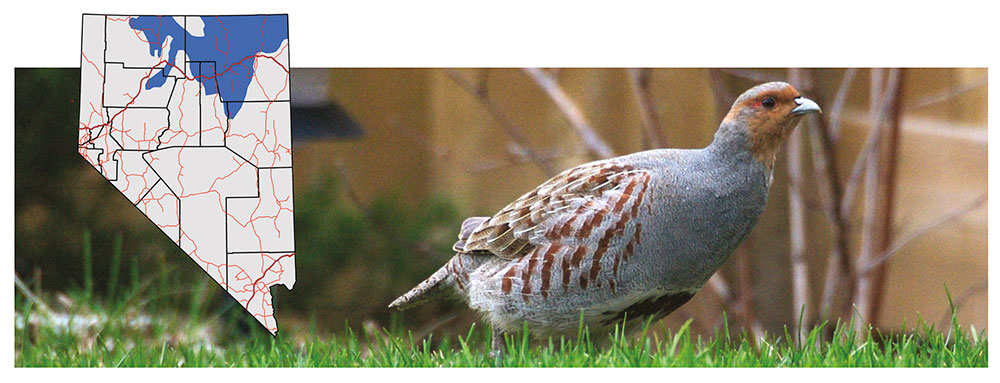
Hungarian Partridge
Officially known as the Gray Partridge. Ranges in size from 11.8 to 13 inches in length and from 13.6 to 17.6 oz. Grayish brown with chestnut barring on wings, dark reddish U-shaped patch on belly, and a reddish throat patch.
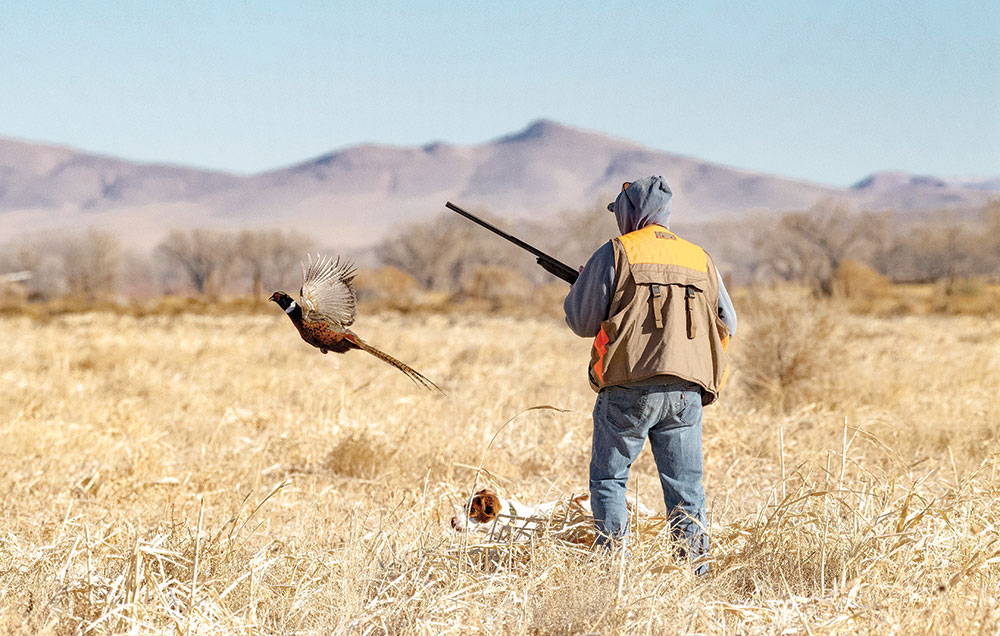
Ring-necked Pheasant
Males are a strikingly beautiful bird with a distinctive green iridescent neck, red face, and white collar around the base of the neck. The body has a copper coloration with black spots and the tail is long and pointed with black barring. The female is dull brown in coloration with black spotting on the sides and a shorter tail than the males. Ranges in size from 19.7 to 27.6 inches in length and weighs from 1.1 to 6.6 lbs.
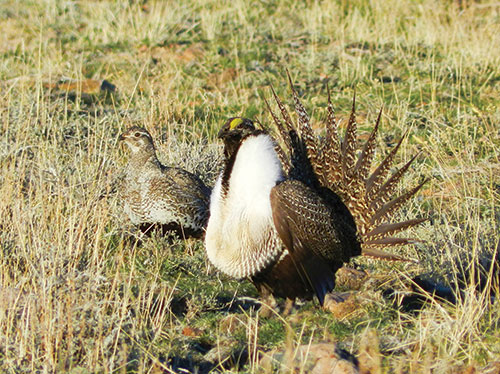
Greater Sage-grouse
The mating display of sage-grouse is very distinctive as the males inflate large yellow air sacs surrounded by white pin feathers and create a series of odd plops and swishing sounds. Males also fan out their spiny tail feathers during the display. Their coloration closely resembles their habitat with a grayish brown appearance and white mottling throughout. Males can be almost twice as large as females. Range in size from 22 to 29.5 inches in length and weigh between 3.1 to 6.4 lbs. Lifespan is from 3 to 6 years with females tending to live longer than males.
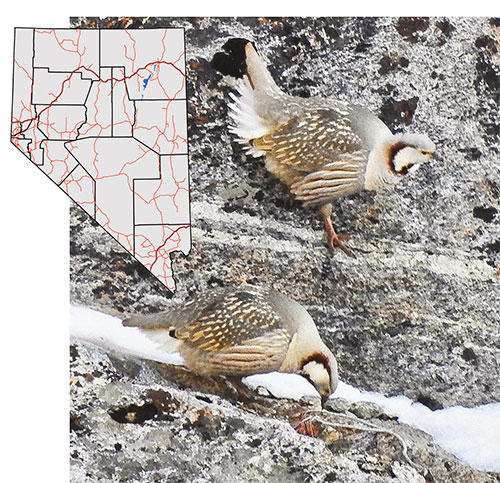
Himalayan Snowcock
A large upland game bird introduced into Nevada in 1963. Ranges in size from 22 to 29 inches and weighs from 4.4 to 6.8 lbs. Gray in color with a white throat and chestnut stripes on the sides of the head. Sexes are monomorphic except for size as the female is smaller in stature. Only exists in Nevada’s Ruby Mountains and East Humboldt Range in North America.
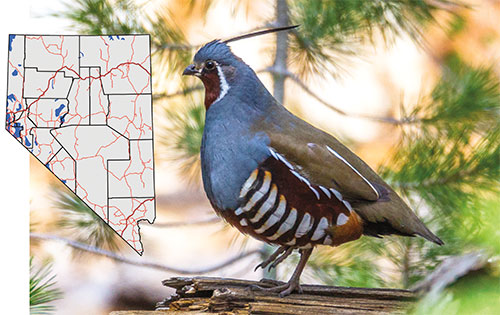
Mountain Quail
The top knot of this species is straight and long compared to California or Gambel’s quail. Chestnut throat patch and chestnut flanks with white bars are distinctive of this species. Ranges in length from 10.2 to 12.2 inches and weight from 6.7 to 9.2 oz.
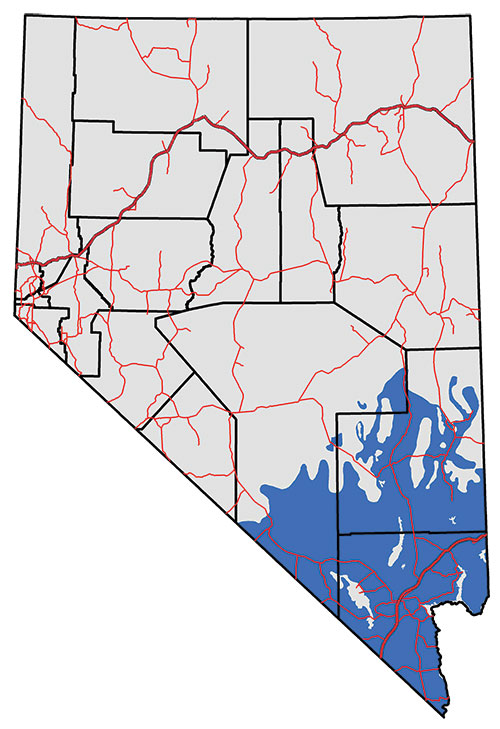 Gambel’s Quail
Gambel’s Quail
Distribution in Nevada includes Clark, Lincoln, and Nye Counties. Similar in color pattern and size to California quail, but male Gambel’s quail have a prominent black belly patch. Range in length from 13.4 to 14.2 inches and weigh between 5.6 to 7.1 oz.
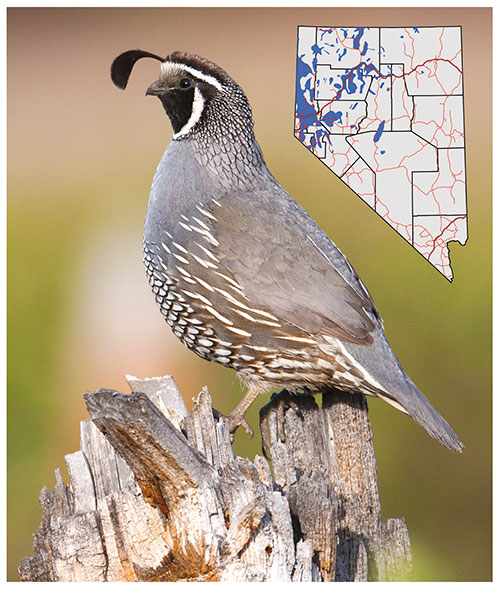
California Quail
Length is from 9.4 to 10.6 inches and weighs in at 5 to 8 oz. Males are distinguishable from females by the black face outlined in bold white stripes and the larger, comma shaped head plume or “top knot” while females are plainer brown and lack the facial markings and have a relatively shorter and fairly straight top knot.
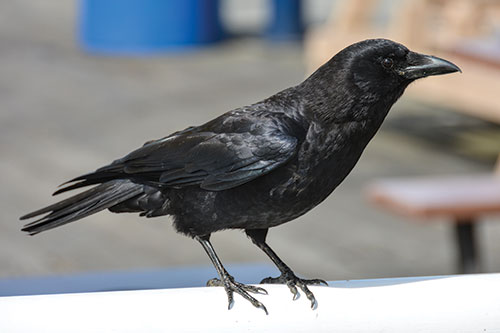
Crow
The crow (17.5 inches) is bigger than a blackbird (9 inches) and noticeably smaller than a raven (24 inches). Crows often flock, while ravens are more solitary birds. Note that the crow’s bill is much smaller than the raven, and that its tail is square. The raven’s heavy bill, shaggy throat feathers, and wedge-shaped tail also set it apart from the common crow.
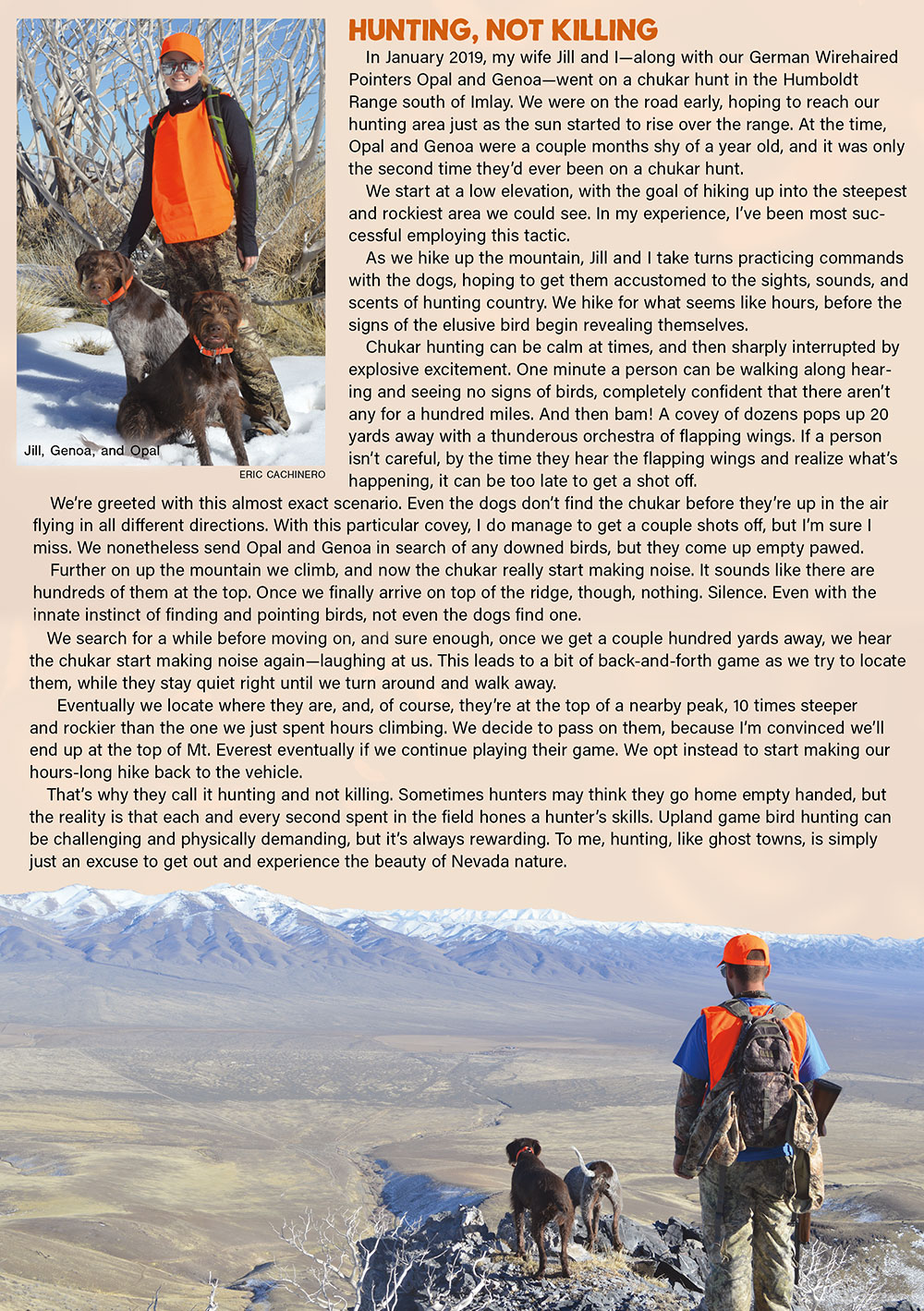
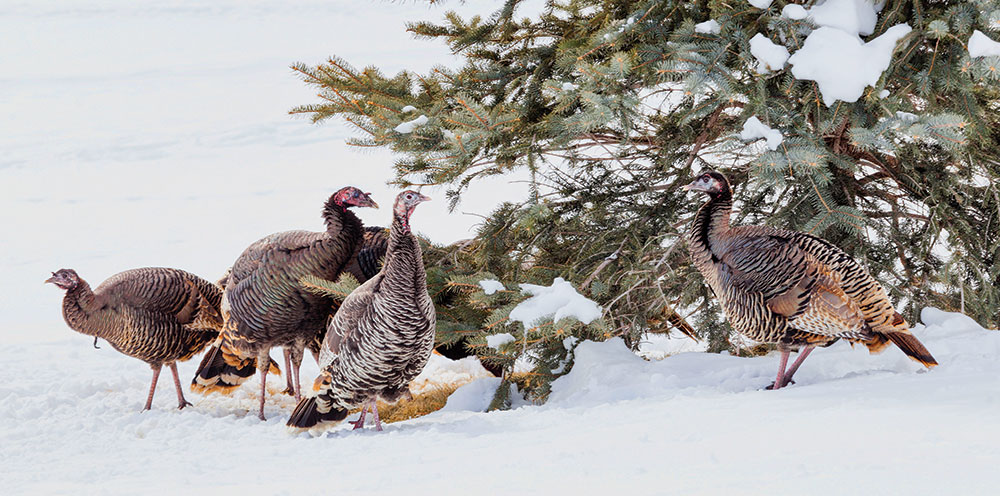
 MORE SMALL GAME ANIMALS
MORE SMALL GAME ANIMALS
In addition to the upland game birds, Nevada allows hunters to try for a host of migratory game birds, including duck, merganser, scaup, geese, coot, snipe, and swan. Doves can also be hunted in the state, and are considered a migratory upland game bird, meaning they fall under special regulations that don’t apply to normal upland game. Nevada also offers turkey hunts. Hunting turkey and migratory game birds also requires different licenses and regulations than upland game, so be sure to consult the “Nevada Small Game Hunting Guide” before pursuing.
Upland game isn’t just reserved for birds either. Upland game hunters can also try their luck with several different rabbit species, including cottontail, pygmy, and white-tailed jackrabbit.
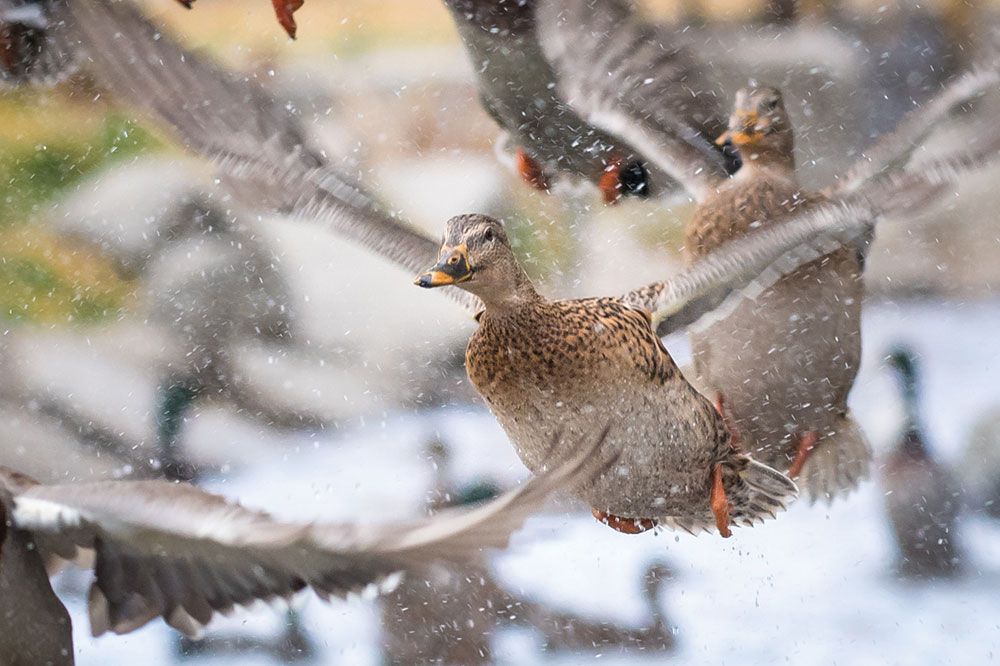
GO AFIELD
No matter where you live in Nevada (and even if you don’t), there are places where you can hunt upland game birds. The sport can be challenging, but the results are rewarding, and pretty tasty, too. Just remember, you’ll have fun the first time, but after that, it’s all for revenge.
